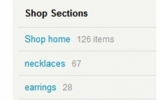What is SEO? Search Engine Optimization (SEO) is the practice of how to get found on Google. It gets your business listed in organic (free) search engine results when someone types in keywords related to your products or service. Have a look at Search Engine Land's video explaining SEO basics.
Top 10 tips for SEO success:
1. Develop SEO keywords list —The first and most important step to get found on Google is to select the best keywords, then consistently use them in all online efforts. Learn more about about keyword selection and how to use the free Google Adwords tool to get your SEO efforts off to a great start.
2. Optimize title tags – The page title should summarize what your page is about. Title tags should be 65-70 characters in length, unique to each page, and written with the most important keyword to the left. Don’t stuff your keywords into your title tags. This is spammy and can actually hurt your ranking.

How To Build an Artist Website
Sign up for our newsletter and get the book How to Build an Artist Website for free!

Title tags are listed at the top of your browser and summarize your page.
3. Optimize meta data – Create unique meta descriptions for each page of your site. The engines pull this ‘snippet’ of text for search results page to help you get found on Google. Keep your meta description to 160 characters if possible so full text is visible on results page.
.png)
Meta descriptions (snippets) are what the search engines pull from your site and deliver in search results.
4. Take advantage of local search – If the majority of your business comes from your area, use this small business tactic for SEO success to your advantage. At a minimum, complete a Google Places page and Bing Business Portal page — both are free and easy to set up. Local search results are most often showed at top of rankings for those searching in your location.
5. Include a physical address – Listing your address tells customers AND search engines where to find you. Include your city/town and state, ideally in the site footer but at least in your Homepage and Contact Us page.
6. Build inbound links – The more links pointing to your site, the more trustworthy Google considers you to be and the easier it is to get found on Google. Ask for links from suppliers, fellow crafters, and friends. Do NOT buy links or take part in reciprocal link exchanges — you’ll be penalized for trying to cheat the system!
7. Use content throughout your site – You’ve heard it before, content is king when it comes to SEO success! Search engines are trying to deliver the best search results. If they find content on your site, the algorithm says you add value to the user. Always incorporate keywords.
On your homepage, include a brief description about who you are and what you do. Use blog posts or articles to add new content frequently, this will improve your visibility in the online world.
.png)
A brief description on your homepage helps the search engines and users understand what your products or services.
Beautiful pictures are perfect for customers but don’t help search crawlers. Spiders can only "read" code to understand your business, they don’t "see" the image. Indie artist Maria Dryden offers great advice on how to write a product description.
8. Avoid duplicate content – A HUGE SEO no-no! When the robots find duplicate content, they penalize the site. They can drop the ranking score or may even knock you out of search results altogether so you won't get found on Google.
The majority of duplicate content is not malicious. It’s often business owners that maintain multiple sites and copy what they’ve already written to speed up work. You CANNOT do this. Nor can you copy someone else’s info, such as "tips for dying cotton," because it’s perfectly written and relevant to what you do.
9. Maximize social media – Maintaining multiple outlets is challenging but the more places you are represented helps with SEO overall. Focusing on the places customers visit is the best use of your time. Pinterest.com is a great option for artists in addition to Facebook. Twitter, and others.
10. Think like a customer first – What do you want on a site? Product offerings… hours and locations… how-tos? Creating a website that meets a customer needs first, will always ensure authenticity and best SEO practices. With time and patience, you’re on your way to small business SEO success.



